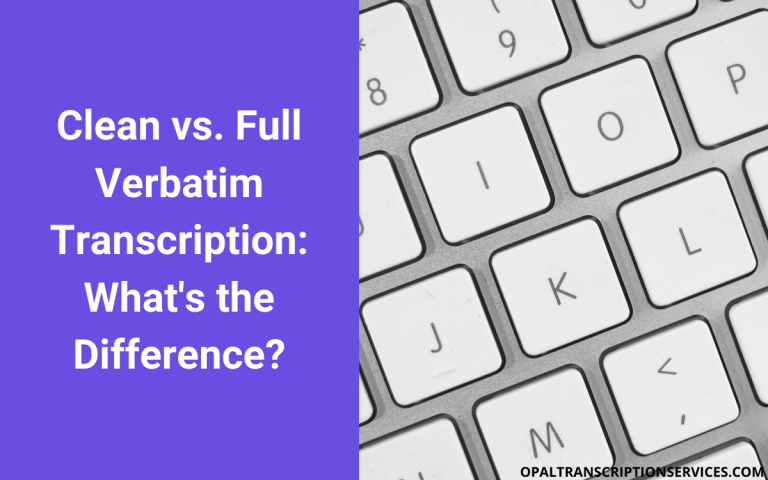8 Best Transcription Headphones in 2024
As a professional audio transcriptionist, your hearing is your greatest asset. A quality pair of transcription headphones can make challenging audio sound clearer, boosting your efficiency and reducing the number of mishears or “unclears” in your transcripts. This translates to happy clients and higher hourly earnings.
Update March 7, 2024: I’m looking for part-time overflow help with academic interview transcription starting in April. Must be based in Canada or the US, have work references, flexible availability (including weekends), and be very responsive to emails. Must be able to turn around 90 minutes of 2-3 speaker audio in three days. Email chloe [at] opaltranscriptionservices.com with your experience and availability (please also add my email to your approved senders). IMPORTANT: Please paste your resume into the body of your email instead of sending it as an attachment or I will not be able to read it. More info: https://www.mondayroadmap.com/transcription-jobs/
When it comes to choosing headphones for audio transcription work, it’s true to a degree that you get what you pay for – cheap headphones can promptly break, or the audio can go out in one ear.
On the other hand, most of us can’t realistically afford to drop hundreds of dollars on a pair of high-end studio headphones.
So for this list of the best transcription headphones, I went in search of the top bang-for-your buck studio headphones. Although I haven’t tried all these headphones myself (I wish!), I chose products that are consistently highly rated by audio professionals – particularly podcasters, who, like transcriptionists, work with recorded speech.
Additionally, I’ve included several headsets that the manufacturers “tuned” specifically for audio transcription – for example, by enhancing midrange frequencies or reducing bass.
I’ve also included one pair of noise-canceling headphones, which I personally use and enjoy for audio transcription work as well as for listening to music.
Before we get to the shortlist, I’ve included tips for choosing the right pair of headphones for transcription work. If you want to skip ahead to my recommended headphones, click here.
Now, let’s talk headphones!
This post may contain affiliate links. See my disclosure for more info.
Types of headphones for transcription
Headphones come in three main styles: in-ear/earbuds, on-ear, and over-ear. Each style has its strengths and weaknesses; however, all three types of headphones can be used for audio transcription work. Let’s look a bit closer at each type:
In-ear headphones and earbuds
In-ear headphones are the kind you insert directly into your ear canal. Because of the tight seal between the headphones and your ear, these headphones have good noise isolation.
Earbuds have small earpieces, or “buds,” that rest in your outer ear. The earpieces may have foam or silicone tips. The sound isolation isn’t as good with these as it is with in-ear headphones, but some people (including me) find them more comfortable.
Some in-ear headphones and earbuds produce a “tinny” sound that lacks bass when compared with headphones that have larger drivers. This isn’t necessarily a bad thing for audio transcription work, where most of the important frequencies fall in the midrange.
In fact, many veteran transcriptionists swear by in-ear headphones or earbuds – particularly the stethoscope, wishbone, or under-chin types designed specifically for transcription. (I’ve included several of these in the list of my recommended headphones below.)
On-ear headphones
These headphones sit on top of your outer ear. They have a band that goes over top or sometimes around the back of your head.
On-ear headphones don’t have the best noise isolation, which can be a problem if you transcribe in a noisy environment. They also tend to leak noise, which isn’t ideal if you’re transcribing with other people around.
However, many people find on-ear headphones more comfortable than in-ear headphones. The sound quality also tends to be better due to the larger drivers. So if you transcribe in a quiet, private office, on-ear headphones may be a good choice.
Over-ear headphones
Over-ear headphones have large earcups that completely encircle the ear. Some designs create a tight seal against the head for greater sound reduction and less noise leakage. In general, over-ear headphones have the best sound quality because of the large drivers in the earcups.
If you transcribe in a warm environment, over-ear headphones can cause your ears to sweat after a while. They can also be a bit uncomfortable if you wear glasses. However, I find wearing over-ear headphones to be much more comfortable than inserting things in my ears.
Over-ear headphones are widely used for professional audio work of all kinds.
Noise-isolating vs. noise-canceling headphones for transcription
Many headphones are designed with noise-isolating features that passively help to reduce external sounds. Examples of these include closed-back earpads or earpieces that create a tight seal between your ear and the headphones.
While these physical features can be useful in reducing higher-frequency sounds, they’re not as good at blocking out lower frequencies – such as the obnoxious thumping of bass from a nearby room or car. Grr!
If you’re frequently bothered by lower-frequency sounds when you’re transcribing, you may want to consider using noise-canceling headphones – that is, headphones that use active noise cancelation (ANC) technology.
Active noise cancelation works electronically by using a tiny mic to pick up external noise and invert the soundwave. This “cancels out” a large portion of the ambient noise, letting you hear more subtle details in the audio. ANC isn’t perfect, but it can be very effective at blocking out lower frequencies.
Noise cancelation uses batteries. Some headphones, like the Bose QC 25, let you use the headphones with or without the ANC so you don’t have to use battery power.
High-quality noise-canceling headphones are usually very expensive. I’ve included one pair of noise-canceling headphones in the list below (the Bose) – and the good news is, it’s high quality and affordable!
Studio vs. consumer headphones for audio transcription work
Headphones can be categorized either as consumer headphones (also called audiophile headphones) or studio headphones (also called monitor headphones).
Consumer headphones are designed to make stuff – music, movies, games, etc. – sound great. In part, the manufacturers achieve this by enhancing certain frequencies, such as bass. This isn’t ideal for audio transcription work, since too much bass can make a dictation sound muddy.
Studio headphones, on the other hand, are used for professional audio work such as tracking and mixing. They’re tuned to have a “flat” (neutral) frequency response so you can hear all frequencies clearly.
In theory, studio headphones are better than consumer headphones for audio transcription because they’re designed to reproduce the original audio as accurately as possible.
That said, no two pairs of headphones are alike, so there will even be subtle differences between different makes of studio headphones.
Also, the way we perceive audio is subjective – you may find that you prefer consumer headphones to studio headphones. After all, you can use a quality pair of audiophile headphones for transcribing and listening to music as well! Therefore, choosing the “right” pair of headphones for transcription work is a matter of experimentation and personal taste.
Transcription headsets
Aside from studio and consumer headphones, there’s a third category of headphones I want to talk about, and that’s headphones that are designed specifically for audio transcription. (Manufacturers typically market them as “headsets,” even though they don’t usually have a mic.)
Transcription headsets are usually manufactured by companies that sell other transcription and dictation gear, such as transcription software, foot pedals, reference books, and digital voice recorders.
They often include the following features to make them more useful for transcription work:
- Inline volume control. This is extremely useful when working with audio files that are very quiet or fluctuate in volume. If your favorite headphones don’t already have a volume control, don’t despair – you can get one for cheap on Amazon.
- Stereo/mono switch. The mono setting can be used for transcribing tapes, if you have clients who still use them.
- Longer cable. This provides greater mobility, if you need it. Any excess cord can be secured with a Velcro tie to make it less of a nuisance.
- Under-chin, wishbone, or stethoscope design. These headphones don’t have a headband, so can wear them for hours without messing up your hair or getting an itchy, sore head.
- USB plug. Unlike 3.5-mm-jack headphones, USB headphones have onboard sound cards that bypass your computer’s sound card. This is helpful if your computer has a lower-quality sound card.
- “Tuned” for transcription. Some transcription headphones are tuned to enhance the frequency range of recorded speech, while reducing that of ambient noise.
Headsets designed for audio transcription usually aren’t as durable as headphones designed by well-known manufacturers of studio and consumer headphones. Also, because of their (typically) USB connections and specific tunings, they don’t make great multipurpose headphones.
On the other hand, they’re very affordable, and you may find you prefer them for audio transcription work.
That’s enough preamble – without further ado, here’s my shortlist of the eight best headphones for transcribing!
Sony MDR-7506
Released in 1991, these studio headphones are still widely used for sound monitoring in broadcast and recording studios. They offer clear, high-quality sound at half the price of many other studio headphones and are consistently ranked highly on headphone reviews.
The MDR-7506s have a rugged design for lasting durability. With their light weight and heavily padded headband, these headphones are comfortable to wear for long sessions. They have good noise isolation, so you can use them for transcribing in moderately noisy environments. Additionally, sound leakage is minimal, so you don’t have to worry about other people overhearing your clients’ audio.
Reviewers describe the MDR-7506s as having clear mids and highs without being too heavy on bass – a plus for audio transcription work. The headphones are foldable and come with a protective case, so you can easily take them with you on trips. The cable is not detachable.
Audio-Technica ATH-M40X
Hailing from Audio-Technica’s critically acclaimed M-Series line of professional studio headphones, the ATH-M40X is another bang-for-your-buck set of cans highly popular with podcasters and other audio professionals.
These headphones are tuned “flat” for accurate monitoring and are built for long-term durability. The earcups are designed to seal tight for good sound isolation and minimal leakage, so you can transcribe in relatively noisy environments – or in quiet ones without people overhearing the audio.
The M40Xs are quite a bit more stylish compared to the utilitarian look of the MDR-7506s above. They’re collapsible and come with a protective carrying pouch. The cable is detachable.
If you’re checking out other products in the M-Series line, you might wonder about the M40X’s two closest relatives, the M50X and M30X. Here’s how they differ from the M40X:
• The M50X is a bit pricier than the M40X and is also very popular with reviewers. However, compared to the M40X, the M50X is a bit more “colored,” with emphasized bass. This isn’t ideal for transcription work, as it can make some dictations sound muddy.
• The M30X, on the other hand, costs slightly less than the M40X and is described by the manufacturer as “tuned for enhanced detail, with excellent mid-range definition.” This makes me suspect that the M30X might be a decent pair of headphones for audio transcription work. However, many reviewers describe the M40Xs as an improvement over the M30Xs, which is why the M40Xs made my shortlist of the best headphones for transcribing.
Sennheiser HD 280 PRO
The third and final pair of bang-for-your-buck studio headphones in this list, the HD 280 PRO is another favorite among audio professionals, especially for critical listening. The headphones are designed with “expressive lows, clear-cut mids, and focused highs” and a “relatively flat frequency response” for accurate audio reproduction.
The HD 280 PRO has minimal sound leakage and excellent noise isolation. The headphones are designed so that instrumentalists like drummers can still hear their monitoring mix while playing loudly. This makes them a good choice for transcribing in busy environments.
The HD 280 PRO is designed with ergonomics and comfort in mind. With their rugged, collapsible design, these headphones will last a long time. Additionally, the earpads, headband padding, and audio cord are replaceable.
Bose QuietComfort 25 Acoustic Noise Cancelling Headphones
I mentioned earlier in this post that I was only going to include one pair of consumer headphones in this list of best transcribing headphones. Well, this is it. The Bose QC 25 is a fav of audiophiles, and it’s also the only pair of truly noise-canceling headphones on this list.
Headphones with active noise cancelation (ANC) are typically very expensive, and Bose is known to have some of the best noise-canceling tech in the industry. In fact, many people purchase these headphones so they can cancel out noise when traveling on a plane.
At approximately $129, the Bose QC 25 deviates a bit from the under-$100 theme of the rest of my list. However, I’ve included it for two reasons:
- I use these headphones for editing/doing a second pass on difficult audio files, and I love them! They’re lightweight and comfortable, and the noise-canceling tech is really something else. I like to transcribe with my window open in the summer, and these headphones block out the sounds of construction workers or lawn mowers. I even sleep with them on sometimes (not recommended if you roll around a lot in your sleep!). Not only are they useful for audio transcription, but music sounds fantastic on them too.
- The Bose QC 25 is massively discounted from its original price of $345 – that’s almost a 63% percent discount. Bose has since come out with the QC 35 and QC 35 II, which are the same headphones as the QC 25 except they’re wireless. So now that the QC 25 is an older release, you can get them at a fraction of the price of other high-end noise-canceling headphones. Despite being “dated,” they continue to outrank newer products in reviews of the best noise-canceling headphones.
The QC 25 is available in two versions: one for Apple devices and one for Samsung and Android devices. The headphones themselves are the same in both versions, but the mic and remote on the cable is designed to be compatible with one type of mobile device or the other. While the headphones can be plugged into and used on your laptop or desktop computer, the inline mic and remote can only be used with your mobile device.
You can order these in white or black (or if you’re an ultra-nerd, you can get them in any color you want for an extra $100).
You need a triple-A battery to power the noise-canceling feature (you get up to 35 hours of noise cancelation per battery). If you don’t want to use batteries, just switch off the ANC and you still have a quality pair of headphones.
The QC 25 offers balanced audio, so you can hear lows, mids, and highs clearly. Unlike many other consumer headphones, they aren’t bass-heavy, which makes them a good choice for transcription work. They’re collapsible and come with a sturdy protective case, so they’re easy to travel with.
These headphones are a no-brainer if you want to experience true noise cancelation without spending hundreds of dollars.
Glimmer under-chin transcription headset
This ultra-affordable pink headset by Insight Headsets has been around for quite a while and is a favorite of many long-time legal and medical transcriptionists. It’s been redesigned for more comfort, greater durability, and better sound quality. Not only that, but it looks pretty cool!
The Glimmer has been tuned with audio transcription in mind. The drivers reduce bass, making deep voices more intelligible instead of muddy sounding. Like many transcription headsets, the Glimmer comes with an inline volume control and stereo/mono switch.
The headset is lightweight and has an under-chin design, so you can transcribe for hours on end without getting a case of headphone hair. The soft earbuds rest on your ears, which I think is a lot more comfortable than the kind you insert directly into your ears.
However, the downside is that noise reduction won’t be great, so if you regularly transcribe in noisier environments, you may want to consider a noise-reducing or noise-canceling pair of headphones.
The Glimmer has a 3.5-mm plug for use with your PC, and it’s also compatible with mobile devices. When you purchase a Glimmer headset, a portion of the proceeds goes to breast cancer research.
Insight Headsets makes another popular headset for transcription called the Caliber.
Spectra USB transcription headset
Designed by VEC Electronics – the makers of the hugely popular Infinity transcription foot pedal – the Spectra is another affordable transcription headset popular among professional transcriptionists.
The headset works with PC and Mac. It’s plug-and-play – no need for additional software or adapters.
Like the Glimmer, the Spectra is a lightweight headset with an under-chin design and foam-tipped earbuds that rest on your ears. Again, this means noise reduction won’t be great, although that’s not a problem if you transcribe in a quiet location.
The Spectra USB headset has a built-in sound card designed to make voices clearer. Indeed, reviewers say the audio is very clear compared to headphones that are designed for listening to music. The headset also has inline volume control. Together, these features make the Spectra a useful headset for transcribing difficult audio.
However, the consensus among reviewers is that these won’t last for years, which is to be expected for headsets in this lower price range. So if you like them, make sure you have a backup set on hand so you can keep working when your current pair wears out.
There is a 3.5-mm right-angle stereo plug version of the Spectra headset available.
AL-60 USB aluminum stethoscope headset
This transcription headset (also by VEC Electronics) will appeal to transcriptionists who are diehard fans of stethoscope-style headsets. The tube-like plastic earpieces project sound directly into your ear canal, providing better sound isolation than the foam-tipped kind.
The AL-60 is adjustable to your head size and has inline volume control. Like the Spectra, it’s plug-and-play.
There’s also a 3.5-mm right-angle-plug version of this headset available.
WordSlinger USB transcription headset
This on-ear overhead transcription headset by Executive Communication Systems (ECS) has a built-in sound card that bypasses your computer sound card and “matches the frequency range of the spoken word.” It also comes with inline volume control.
According to the manufacturer, the headset is designed to improve the sound of distorted files with low volume. Reviewers largely agree that the WordSlinger does make audio recordings clearer and louder. Like the Spectra, there are some complaints about the durability of the product, but again, that’s pretty common for headphones in this lower price range.
The WordSlinger headset is plug-and-play and compatible with all versions of Windows and Mac. It has an adjustable foam-padded headband and earpads.
If you’d prefer an over-ear version of this ECS headset for better noise isolation, check out the WordMaster transcription headset. I believe this is a newer release, so there aren’t as many reviews for it yet. Existing reviews say the audio is clear, although a couple of reviewers mentioned the headband is a bit large.
Wrapping up
I hope this post helps you choose a pair of headphones that makes transcribing audio a pleasure.
Remember that choosing a great pair of headphones is a subjective process. You can read all the product reviews on the Internet, but at the end of the day, there is no all-around “best” pair of headphones for audio transcription. The audio we work on varies from dictator to dictator – and the way we all hear things is different, too.
So roll with what works for you, and don’t let any audio snob tell you your headphones suck!
Now it’s your turn. Do you like your current transcription headset? What would you recommend as the best headphones for transcribing? The comments are open!


![6 Best AI Video Editor Tools [Ranked and Reviewed]](https://www.mondayroadmap.com/wp-content/uploads/ai-video-editors-768x480.png)
![6 Best AI Video Upscaling Software [Free and Paid]](https://www.mondayroadmap.com/wp-content/uploads/ai-video-upscaling-768x480.png)



I haven’t purchased a new pair yet, but I just wanted to thank you for this article. I’ve been tirelessly searching to find a good headset during an extremely voluminous job. I’m looking to speed up the process with good quality. Thanks for your advice and expertise.
This was a MOST informative article. 🙂
After reading, I leaned toward the Bose noise-cancelling headset; unfortunately, that model is no longer available, and its upgrade is too expensive. But I also liked the info re the Audio-Techa headset, and that’s what I ended up ordering.
I very much appreciate all your explanations of the different types of headsets. I do transcription and was unaware that “studio” headphones might actually be something I could use (vs. ones that are “tuned” more for music listening only). Your article clarified several things for me, helping me make a good decision for my needs. So, thanks much for taking the time and sharing your expertise.
Thank you for all your research work. My main complaint, as a transcriptionist, is that my ears are too sensitive to wear over-the-head earphones for too long. I have the same problem in recording sessions (am a musician), giving me a tension headache and very unhappy face! So, for me, the under-the-chin versions sound great. I’ll check them out.